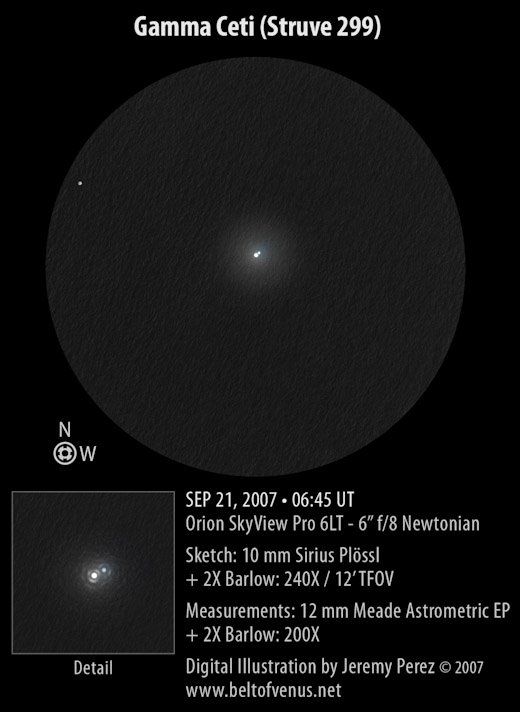Double Star of the Month:
Gamma Ceti
AKA: Kaffaljidhma; STF 299
Position: 02 hr 43.2 min +03 degrees 14 min 09 sec
Due south at 23:04 (GMT) on 15 November 2021
Image credit: Jeremy Perez (http://www.perezmedia.net/beltofvenus)
Used with permission
The Danish-Russian astronomer Wilhelm Struve at the observatory in Dorpat (now Tartu, Estonia) created an enormous catalogue of double stars between the 1820s and 1840s. He discovered over 5,000 double stars and his main catalogue contains over 3,000. One of his favourite double stars was Gamma Ceti. This is not an easy double star to observe and you will need a high magnification. The primary is a fairly bright 3.5 (although it may be difficult to see in Havering with the naked eye), but the secondary is a dim 6.2. The difference in brightness and a narrow separation of 1.9 arcseconds make it challenging in a small telescope. It was easier for Struve; he had a six inch refractor and the separation when he found it in 1825 was 2.8 arcseconds. It is a physical system and there is a third member, but C is both dim (10.2) and wide (843 arcsec); it is roughly in the same line as A and B. The system is relatively close at 80 light years distant.
The main interest of Gamma Ceti lies in its colours. The main star is spectral type A3, which should be seen as blue (or white) and the secondary is F3, which should be white or pale yellow. However, as I have pointed out before, when a double should be blue and yellow, it is in fact seen as yellow and blue, and this is how Thomas Webb saw it. I see it as yellow-green and dark green. The primary is sometimes called olive-green and the secondary tawny. It is not an easy star to spot, being in a region of fairly dim stars. It forms the apex of a pentagon of stars at one end of Cetus (traditionally the mouth of the sea monster, but the tail in H.A. Rey’s version), but as three of the five stars are fourth magnitude this is not very helpful. It can be best located by drawing a line between Sirius and Rigel, and then continuing by somewhat more than as much again (or one can use the belt stars of Orion). This should bring you to a pair of stars Alpha Ceti (Menkar) on the left and the somewhat dimmer Gamma Ceti (Kaffaljidhma) on the right.
